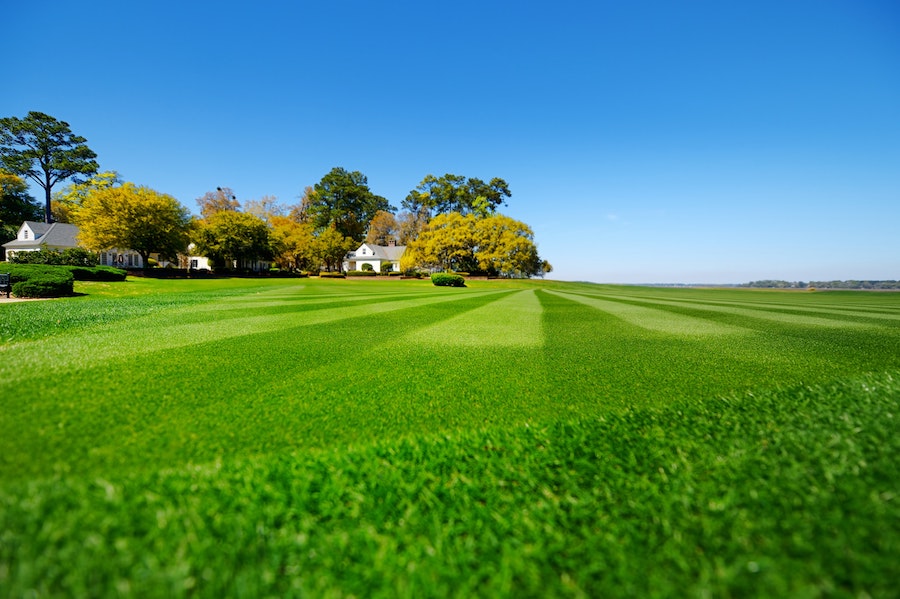7 steps to a lovely lawn
The ground may be hard at the moment – but once the weather warms up a bit and you can get your fork into it, it’ll be time to get the lawn shipshape for summer.
Large lawns may have become less prevalent in recent years, given the relatively high amount of upkeep they require and the lack of space so many of us have, but grass does make fantastic foil for planting and is cool and restful to the eye.
So, where do you start?
Here are some basic steps you can take to help your lawn recover from the depths of winter, and hopefully ensure you have a carpet of green velvet to enjoy during the warmer months…
1. Scarify

Get rid of moss
The best way to get rid of the rubbish is to scarify the lawn with a springtime rake to remove moss, thatch (dead grass below the living shoots), and any other debris smothering the grass. This will let in much-needed light and oxygen, promoting better growth.
2. Aerate the lawn

Use a fork to make drainage holes
Getting oxygen down into the soil, improving drainage so your lawn doesn’t become waterlogged, and reducing compaction can all be achieved by aerating your lawn. To do this, you can either drive a garden fork into patches of your lawn which have particularly poor drainage, working it backwards and forwards to enlarge the holes, which should be at about 15cm intervals.

Spiked lawn shoes are an alternative
Alternatively, you can use spiked shoes which are made especially for lawn drainage, although I’ve always found them awkward and cumbersome so I’d recommend the fork option. Once you’ve made your holes, brush in sharp sand, which will improve drainage and stop the holes from closing up again.
3. Feed the grass

Feed your lawn
Feed the grass with lawn fertiliser available at most garden centres. This can be done by hand, and follow the instructions to make sure you’ve added the right quantities before watering it in. Some lawn dressings incorporate a slow-release fertiliser but if this isn’t the case, add a little amount of general lawn fertiliser (not containing weed or moss killer) before applying it. Make sure you brush it evenly over the area, or it will become patchy when the fertiliser kicks in. A few weeks later, if your lawn is still patchy, oversow it lightly with a quality lawn seed.
4. Get rid of lumps and bumps

Smooth out bumps
If you’ve got bumps in your lawn that are likely to be scalped by the mower, or unsightly dips which are a nuisance underfoot, rectify the uneven areas by cutting out the turf over the area and adding or taking away soil underneath. Lift enough to cover the area plus an overlap, remove the lump or fill the hollow and then replace the turf.
5. Repair lawn edges
If you have a damaged lawn edge, first cut out a rectangle of turf incorporating the affected grass with a half moon edger, using a straight edge such as a plank of wood as a guide. Then turn the turf around so that the damaged edge is nearer the middle of the lawn. The gap created by the jagged edge, which is now further into the lawn, should be filled with garden soil, sifted to a fine tilth. Then you need to firm and level it to make sure it is flush with the surrounding grass.

Re-seed bare patches and they will soon look better
Sow grass seed on top, water well, and cover the hole with clear plastic sheeting until the seeds have germinated, to help retain moisture and keep birds at bay. Reseeding worn areas and bare patches should be done towards the end of March or in April if the weather is extremely cold and the ground soggy.
6. Deal with worm casts

Worm casts can be a nuisance
There are pros and cons to wormcasts. Worms are to be encouraged because they help aerate the soil underneath the lawn and add organic matter. But wormcasts can be a problem for many, as they form perfect seedbeds for weeds, so they need removing from the lawn with a stiff broom before the first mow.
7. Know when to mow

Mow when the grass is actively growing
Mowing should certainly not be done when the grass is wet or frozen – don’t even walk on it in those conditions. Wait until the grass is actively growing, when the weather has warmed up. When the grass is about 8cm high, you can cut it for the first time. But make sure the mower blades are sharp and set them high – and don’t leave your clippings on the lawn in spring.
The Press Association
Latest posts by The Press Association (see all)
- 5 new books to read this week - November 23, 2024
- 3 easy Mary Berry recipes to make this season - November 22, 2024
- In Pictures: Party stalwart kept New Labour in touch with traditional supporters - November 21, 2024
- 6 easy indoor exercises to try this winter – and why they are good for you - November 19, 2024
- Martin Clunes: I can’t afford to retire – I’ve got too many horses - November 19, 2024





















